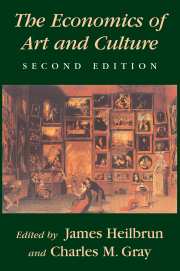Book contents
- Frontmatter
- Contents
- List of figures and tables
- Preface
- Part I The arts sector: Size, growth, and audiences
- Part II The microeconomics of demand and supply
- Part III The fine arts and museums
- Part IV Public policy toward the arts
- Part V Art, economy, and society
- 14 The arts as a profession: Education, training, and employment
- 15 The role of the arts in a local economy
- 16 The mass media, public broadcasting, and the cultivation of taste
- 17 Conclusion: Innovation, arts education, and the future of art and culture in the United States
- Index
16 - The mass media, public broadcasting, and the cultivation of taste
Published online by Cambridge University Press: 05 September 2012
- Frontmatter
- Contents
- List of figures and tables
- Preface
- Part I The arts sector: Size, growth, and audiences
- Part II The microeconomics of demand and supply
- Part III The fine arts and museums
- Part IV Public policy toward the arts
- Part V Art, economy, and society
- 14 The arts as a profession: Education, training, and employment
- 15 The role of the arts in a local economy
- 16 The mass media, public broadcasting, and the cultivation of taste
- 17 Conclusion: Innovation, arts education, and the future of art and culture in the United States
- Index
Summary
Art is said to be an “acquired” or “cultivated” taste. That is in no way a disparaging statement. It certainly does not imply that a taste for art is somehow unnatural, artificial, or pretentious, as if all those people who claim to enjoy listening to Beethoven's string quartets or Bach's canatas were just kidding. Rather, it means that one has to be familiar with art to find pleasure in it, and the more familiar with it you become the more pleasure you find.
As pointed out in Chapter 4, taste is obviously one of the most important variables determining the level of consumer demand for art (or for any other consumer good). If the public's taste for art increases, the demand curve for art shifts to the right along the supply curve: Unless the supply curve is perfectly vertical, more will be produced and more be purchased (see Fig. 4.7). But if taste itself depends on exposure, we are in danger of being trapped in a suboptimal position, in the following sense. Some expenditure of time and/or money by consumers in making themselves more familiar with art would yield gains in future utility more than sufficient to cover the outlay. The optimal (and rational) decision would be to make the outlay, but since consumers are unaware of the possible future gain, they do not do so. To put it in less formal terms, consumers would greatly enjoy art if they were familiar with it; however, familiarity comes only with exposure, and the public will not expose themselves to it since they have not the taste.
- Type
- Chapter
- Information
- The Economics of Art and Culture , pp. 360 - 384Publisher: Cambridge University PressPrint publication year: 2001



